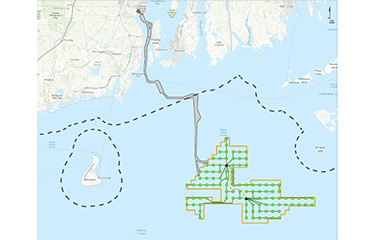Fishermen from Connecticut, Rhode Island, and New York are providing vessels to help offshore wind developers Ørsted and Eversource in what the joint venture partners are calling the first substantial contract with “a commercial fishing consortium in the history of U.S. offshore wind.”
Sea Services North America, based in Waterford, Connecticut, U.S.A., and its fishermen partners will work in and around the companies’ Northeast offshore wind developments, including the 704-megawatt (MW) Revolution Wind project, the 132 MW South Fork Wind project, and the 924 MW Sunrise Wind project.
The company’s work “ensures enhanced safety and protection of the ocean environment, but also will support the region’s economy by creating new jobs and providing an economic opportunity for our fishermen,” Sea Services CEO and Co-Founder Gordon Videll said.
Starting in 2020, Sea Services fishermen helped Revolution Wind survey vessels to locate, identify, and avoid gill-nets and other fixed gear. During that pilot project, its fishermen worked 150 days and traveled more than 6,000 miles to assist the vessels “without any gear conflict,” Videll told National Fisherman.
“That was a lot or preparation” to ensure the scout boats met the international offshore wind industry safety protocols, he said.
“The challenge is how do we get an American fishing vessel up to these standards,” Videll said.
Ørsted and Eversource provided the resources for upgrading safety equipment, conducting detailed vessel surveys, developing safety management systems onboard, and training – including helping captains obtain 100-ton mariner licenses, Videll said. For the coming phases of construction and operation, Sea Services is preparing seven contract vessels and negotiating for more, he said.
A recent joint announcement from the wind developers comes as the U.S. Bureau of Ocean Energy Management (BOEM) accelerates its environmental reviews of as many as 10 East Coast projects by the end of 2021. Industry advocates are making the case that wind development can coexist with commercial fishing and other maritime industries.
“We believe strongly that offshore wind can coexist with all ocean users, including the region’s commercial and recreational fishing fleets,” Ørsted Offshore North America CEO David Hardy said. “Our expanded collaboration with Sea Services will help us as we strive to achieve that coexistence, with the valuable support from fishermen who know the area’s waters best.”
Kenneth Bowes, vice president of siting and permitting for Eversource, said the companies are committed “to engage other ocean users, such as commercial fishermen, throughout the full life-cycle of our projects and utilize local partners to bring commercially successful and mutually beneficial projects to life.”
Videll and his Sea Services colleagues, Gary Yerman and Mike Theiler, said their decision to get involved came after they, like many southern New England fishermen, were approached “dozens of times” by wind development companies in recent years.
“I think we were basically the first guys who didn’t throw them out of the office,” Theiler said.
“Anybody one who heard about this from the fishing side, there’s a lot of skepticism,” Videll added. “Nobody wants to see the apple cart turned over. But it pays to do your own diligence.”
The three decided to see for themselves with a 2019 visit to view how offshore wind was operating in Europe, a trip that took them to the port of Kilkeel, Northern Ireland’s largest fishing port, located on the Irish Sea.
“It was almost like driving into New London,” Videll said of the resemblance to his hometown in Connecticut. “It was like, this is what New London should be like. Every storefront filled, the waterfront bustling.”
Talking to local captains and seeing conditions in the fleet, the Americans said, showed them how working for offshore wind companies was boosting fishermen’s incomes.
“What we saw was coexistence,” Videll said. “We had a business plan by the time we got home.”
To do that kind of work here, Sea Services is talking to captains from New England ports including New Bedford, Point Judith, Cape May, and Gloucester, he said.
Theiler said the history of Connecticut’s lobster fishery shows the need for fishermen to have diversified options. Since a 1999 die-off that lobstermen widely blamed on pesticide-spraying, and warming average water temperatures, “the industry has gone from 600 participants members to, say, 60.”
“We survived a disaster and they only way we do that is by diversifying,” Theiler said. “This is an opportunity for fishermen to give them some other work that’s good paying, that doesn’t necessarily involve leasing quota or days at sea. So yeah, there’s going to be pushback, because things are good in a lot of fisheries, but as soon as that turns around and you’ve got a boat and a family and a mortgage and a crew…Realistically, in my world we’ve been preparing to do other work for a long time.”
With its consortium model, Sea Services management negotiates contracts with offshore wind developers, provides vessel inspections, pays day rates and fuel, increases safety standards, facilitates crew training and coordinates best in class reporting systems and software to the developer.
For offshore wind developers, the company provides customized reporting; best-in-class health, services, and environmental policies; qualified vessels and safety inspections; ready captains and crews with preliminary training; and “complete on-water coordination, to ensure safety and the maximum uninterrupted days at sea," it said.
Reporting by Kirk Moore
Photo courtesy of the Bureau of Ocean Energy Management







